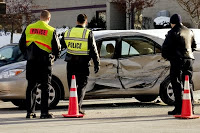
National Drivers Test Highlights
June 17, 2011
Every year, GMAC Insurance offer up a National Drivers Test available for all, regardless of age or state, in order to get a better insight on how motorists are driving around the country. This test usually yields interesting results, such as which is the state with the most capable drivers, or which age group is best at driving performance on the road.
According to the test, these are the top 10 states when it comes to knowledgeable drivers:
1. Kansas
2. Iowa
3. Colorado
4. Minnesota
5. Oregon
6. Nebraska
7. Indiana
8. Missouri
9. South Dakota
10. Wyoming
They have also found that:
- 1 in 4 women failed the test (27.2 percent versus 13.6 percent for male).
- The Northeast is the worst driving region, while the Midwest is the best, based on test scores.
- The elderly succeed. Out of all the test takers, those that belong in the oldest group, aged 60-65 have the highest scores.
- New York and Washington: 1 out of 3 of all drivers in both states failed the test. Be careful on these roads. While New York did move a couple of notches from the bottom of the test results last year, it’s still valid to point out that a majority of NY drivers are getting something wrong on the test.
Do you think this data accurately represents reality? Now in its 7th year, the GMAC Insurance National Drivers Test point out that drivers have improved all over the nation in the last year, but it still tells a sad reality that a large number of people still lack basic driving knowledge. 85 percent were unable to point out the proper course of action when faced with a yellow light, while only a quarter of all test takers were aware of safe following distances.
There’s a lot to be said about the validity and accuracy of tests like these, but there’s more to be said about the results that we’re getting. Law enforcement and driving advocacy groups should see options such as driver’s education in schools and other such initiatives to make sure that year after year, points only go up — along with that, the percentage of safety on the road.
Project Ignition Brings out the Best in Teen Driving Safety
June 3, 2011
Since 1983, the National Youth Leadership Council has strived to “create a more just, sustainable, and peaceful world with young people, their schools and their communities through service-learning.” They have been coordinating a lot of initiatives, research/leadership programs and professional development programs for over two decades now.
The one we will be focusing on is Project Ignition, which brings out the best in students, teachers and the community when it comes to creative service-learning programs designed to promote teen driver safety.
What is service-learning?
In their words, service-learning is “learning in action.” Creating a driving safety video about seat belt safety is a service. Sitting in front of a computer, watching that seat belt safety video is learning.
Service-learning is a method of teaching that puts the ball in the hands of the students, teachers and the community. With the freedom to create something based on things that they know their peers will learn from, regardless of the method of delivery, but also inclusive of things one might learn from a classroom creates a service-learning program that will be easier to comprehend. It is learning in action.
So what is Project Ignition, and how does it fit into all this?
Project Ignition is a service-learning grant program focused on providing high schools with great teen driver safety-focused service-learning ideas and giving them the spark necessary to get these ideas happen.
These ideas may engage students, teachers and the community to evaluate how they fit into the whole teen driver safety issue, and what can and must be done for them not only to be the cause of safety, but also influence attitudes and spread the overall message that not only do their peers care, but also the community. The impact of these ideas may change city policies; it may give students a platform for a dialogue with lawmakers they otherwise wouldn’t have got to; it may bring out stories from families of teen driving crashes; at the very least, these ideas might change minds.
The ripple effect achieved by these ideas is like throwing a boulder into a small pond.
What Project Ignition does to get these service-learning ideas started is provide a $2,000 grant for 25 selected schools which may enable the idea to become reality. But it doesn’t stop there: the 10 best out of the 25 schools selected stand a chance of becoming one of the Project Ignition National Leader Schools. Leader schools will be given the chance to expand their original campaign for a second year with a funding of $2,500, along with $5,000 to support their participation in the National Service-Learning Conference in 2012.
How do I get our school’s teen driver safety service-learning idea funded?
Project Ignition’s contact details are on the site. Application for becoming one of the 25 selected schools (in the US or Canada) is open in August, but interested parties may contact them as early as now. http://www.sfprojectignition.com/
Image: statefarm.com

5 Things A Teen Driver Must Do To Handle A Crash
May 9, 2011
If you compare industrialized nations, some may say the US has a poor record of teaching young drivers how to drive. Instead of the requirement to be taught by professional driving instructors, American teens are taught to drive by their parents who, with few exceptions, are ill prepared to teach their teen how to drive. As a result, many teens are sent out on the road without the proper training or experience to handle a lot of the driving situations they will be faced with. Unfortunately, in the United States, that means that the chances of a teen becoming involved in a collision within the first year of driving are very high. Since the chances of a teen driver being involved in a motor vehicle collision are so high, teens should, at least, be prepared to deal with the aftermath of a crash.
Here’s a brief checklist of what a teen driver must know, when involved in a crash:
Don’t place blame, remain calm – This is much easier said than done given the emotions involved in a crash however, remaining calm can help defuse a potentially volatile situation. Tempers can flare after a crash and there is the potential for a “road rage” attack. Losing one’s calm can’t “un-crash” the vehicles so it is imperative that the teen remain as calm as possible. If the other driver becomes confrontational, stay in the car and wait for the police. There may be a temptation to run but the teen should be aware that he or she could be arrested for leaving the scene of a collision.
Check immediately for injuries to other drivers. Call Rescue, if necessary. – If anyone involved was hurt, the first priority is to call 911 for medical assistance. First aid should be applied to stop bleeding but, to prevent even greater injuries, an injured victim should never be moved unless there is a greater chance of further injury from fire or a secondary collision from oncoming traffic. Never give injured victims any water.
Emergency packs – Your car should be stocked with first-aid kits, emergency flares or reflectors, tools, and any other items that may help in case of a crash. Reflective triangles or flares placed at least 100 feet away from the crash will help to divert other traffic away from the crash site. If the collision occurred around a sharp curve or other obstruction, someone should be sent to wave down or otherwise warn oncoming traffic of the danger ahead.
If the vehicles can be moved, they should be moved off the roadway as quickly as possible. If the vehicles can’t be moved, all victims who are capable of walking should be moved well off the roadway to a safe location to avoid secondary collisions.
License, insurance, and registration – Your teen should always know where the vehicle’s registration and proof in insurance card are located. They should always be kept together in an envelope in the glove box. Most state laws require that drivers who are involved in a crash share their driver’s license number, vehicle registration, proof of insurance, and current address with law enforcement officers and other persons involved.
In most states, if a collision results in more than $500 in damages either to vehicles, or public or private property, the police must be called. If the police are not called, a formal report must be made to local law enforcement within 24 hours.
Documentation – Nowadays, with cell phones, a camera is never far away. Take pictures of the crash site and any damages that may have occurred. Note and take pictures of conditions, such as weather, roadway hazards, or whether or not the sun’s position may have blinded a driver, etc. Get the names and phone numbers of any witnesses. If the collision results in a court case, having as much documentation as possible will help.
A car crash is no time to panic or lose one’s cool. Handle it properly and there will be fewer hassles, in the long run, for the teen driver.

Prepping for a Safe Prom: Communication
April 22, 2011
“To effectively communicate, we must realize that we are all different in the way we perceive the world and use this understanding as a guide to our communication with others.”
-Tony Robbins
Prom season is fast-approaching and many parents are busy helping their teens gear up for one of the most exciting time in their teen’s life. Often overlooked is the need for these preparations to include frank, specific, and honest discussions with teens about how to stay safe and avoid alcohol or drugs on prom night.
Most of the teens shrug off their parents’ advice, believing the discussion stems from parents not understanding that their teens just want to have a fun carefree night. But in reality, this comes from a place of understanding: these parents had proms in their day, and know how easily things can spiral out of control. It’s usually guidance on helping teens avoid decisions they might regret.
Here are some tips on exactly what to discuss:
- Communicate with other parents; then, talk to your teen about their friends’ parents. Being part of a social group does not guarantee that other parents share the idea of a zero-tolerance policy for alcohol. Some parents even choose to “look the other way” when hosting teen get-togethers, reasoning that at least, the teens are in a “safe” environment. This is illegal in any state. Communicate with these other parents to find out if they know where their teens will be after prom night. Even better, if the teens plan to spend time in another teen’s home, find out if the parents are willing to chaperone. Communicate the importance of accounting and locking up alcohol in their homes. When communicating with your teen, make sure that they know that it’s always alright to say “no.” Ask if they will be riding with teens whose parents also have a zero-tolerance policy for alcohol.
- Come up with a safety code. This could be something a teen may text their parent if they are in an uncomfortable situation, and they need an exit. Something like a code to signal, “get me out of here!” On your end, make sure that your teen knows that you will be discrete upon receiving this code. This could also be something that a teen can do to “check in” with their parents. Maybe texting something like, “dinner was awesome!” could mean that the teen has arrived at an after-prom destination safely.
- Discuss the teen’s planned itinerary for the evening, and require the teen to inform you of any changes. Make teens feel they could trust you not to bug them on prom night, if they promise to keep their end of the bargain by checking in and informing you of any changes in the plan.
Doing so will hopefully make prom night a “night to remember,” instead of being “the night when my mom bugged me all night, until I got home.” Pre-plan, communicate and have fun!
Ford Driving Clinics Coming to Schools
March 22, 2011
Ford’s Driving Skills for Life, a group focused on teen driving safety will be going around schools to set up driving clinics for teens. Ford DSFL is focused on correcting the most common teen driving mistakes which are; speeding, spacing, vehicle handling, and distractions.
They teach these in their Ford driving clinics through 3 different exercises for teens. The goal is for the teens to experience first-hand how the lack of training or knowledge may lead to disaster down the line. The three exercises are:
- Vehicle handling – In this one, the rear wheels of the car are intentionally loose, causing the vehicle to skid when approaching turns. The goal of this exercise is to teach teens what to do in situations like that.
- Distracted Driving Course – The goal of this is to show that the inside of a vehicle is full of distractions — and ways on how to deal with them while staying focused on driving.
- Impaired Driving Course – Students will be wearing “fatal vision” goggles that impair vision, to show that drivers are not truly able to operate a vehicle under the influence.
The Ford DSFL tour is a 30-city, 15-state driving clinic to be held in high schools. For a full listing of schedules, check out their Ford DSFL Site.
Photo Courtesy of: Ford Driving Skills for Life
